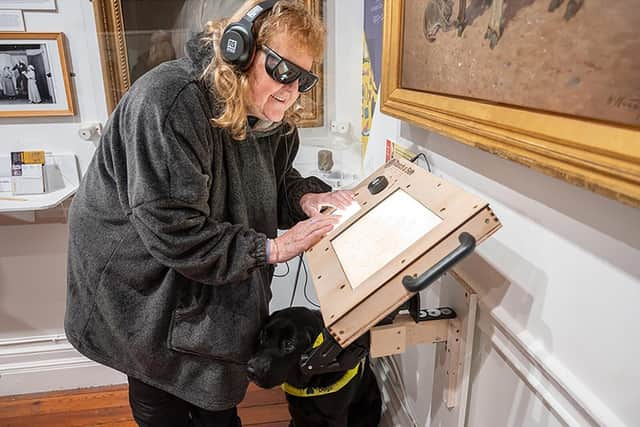How people with sight loss can “touch and see” 3D artwork at Lancaster museum
and live on Freeview channel 276
People with sight loss have welcomed a project enabling them to appreciate paintings at Lancaster Museum using touch.
The School of Engineering at Lancaster University, Lancaster City Museums and Galloway’s Society for the Blind have worked together on the Touch & See project, which aims to improve accessibility for a range of users.
Advertisement
Hide AdAdvertisement
Hide AdA key part of this is the generation of lithophanes, which are 3D relief representations of 2D images, made using 3D printing technology at the School of Engineering.


The project has developed a range of sizes and variations of lithophanes plus a haptic stand to hold the illuminated lithophanes and provide audio descriptions of the images, guiding the person to touch specific points.
The project was tested with local focus groups at Lancaster Museum, who were overwhelmingly positive when discussing the combination of lithophane, lightbox and audio description.
James said: "I think the audio description was really good because it gave you the impression of where to start from. It said to start with the donkey in the middle, like a basket and then you can work following that with your fingers.”
Advertisement
Hide AdAdvertisement
Hide AdMike said: "I really think it works well. Obviously, the light definitely enhances the image on the lithophane, and the audio adds more to it and guides you around it, so it gives you an overall expression of what is there."
The concept of the haptic stand has been developed with engineering students as part of a two-week-long project that links industry with undergraduate students. The projects help develop students’ technical and professional skills whilst providing research and development expertise to a range of organisations.
Engineering researcher and student Nathan Lister said “Being a part of this project is inspiring, as we see how technology such as additive manufacturing and 3D Printing can be used in multiple ways to aid others. We hope our displays will create an immersive experience that helps bring 2D history to 3D reality.”
Lancaster University Psychology researcher Kamila Jablonska gathered the feedback.
Advertisement
Hide AdAdvertisement
Hide AdShe said: “Gathering user feedback is an essential part of our project as it provides unique insights into needs and challenges that people with sight loss experience. Expertise of people from Galloway’s Society ensures that our lithophanes are clear to read and the haptic stand is accessible for visually challenged individuals. So far, the participants have made a huge contribution to the development and changes we made to our 3D relief representations.”
Chris Lambert, Lancaster University’s Programme Manager for Engineering Engagement said: “This is a remarkably successful project that has brought together three unique organisations with very different perspectives and expertise. This diversity has undoubtedly contributed to the success of the project and the solutions that have been developed by our engineers. It is a partnership we anticipate will grow as we seek further funding opportunities to scale-up our solutions so that other places of historic and cultural significance can benefit from using technology to increase accessibility.”
The long-term aim of the project is to generate a low-cost solution for small and medium-sized museums and galleries, which can be tailored to their own buildings, environments and collections. The team are continuing to iterate and test the product, gaining valuable feedback to incorporate improvements into the functionality and assembly of the unit.
Exhibition officer at Lancaster Museums, Ivan Frontani said: “Our museums in Lancaster are evolving to give access to blind and partially sighted people and to make them feel more included. With professional help from Lancaster University and Galloways, the technology is now available to make it easier and more affordable to create accessible exhibitions. These displays come alive for everyone by offering not just sight, but all the senses.”
Advertisement
Hide AdAdvertisement
Hide AdAndrew Coleman, Learning Skills & Lifestyle Manager for Galloway’s, said: “At Galloway’s we are delighted to be part of this pioneering project. This is a fantastic opportunity for the Galloway’s community to shape the future of exhibits, making them accessible to those with a visual impairment”.
Whilst the initial concept came from supporting people with sight loss, a multi-sensory method of engaging with artwork is likely to benefit other visitors too, including school children, those with a cognitive impairment (such as dementia) and individuals who identify as neurodivergent.
The next stage of the project will see the unit undergo further technical development before being deployed at selected locations around the UK in our associate partner network.
The co-designed project is funded by the Engineering and Physical Sciences Research Council (EPSRC) Impact Acceleration Account, which supports Lancaster University researchers to translate their work into broader societal and economic benefits.